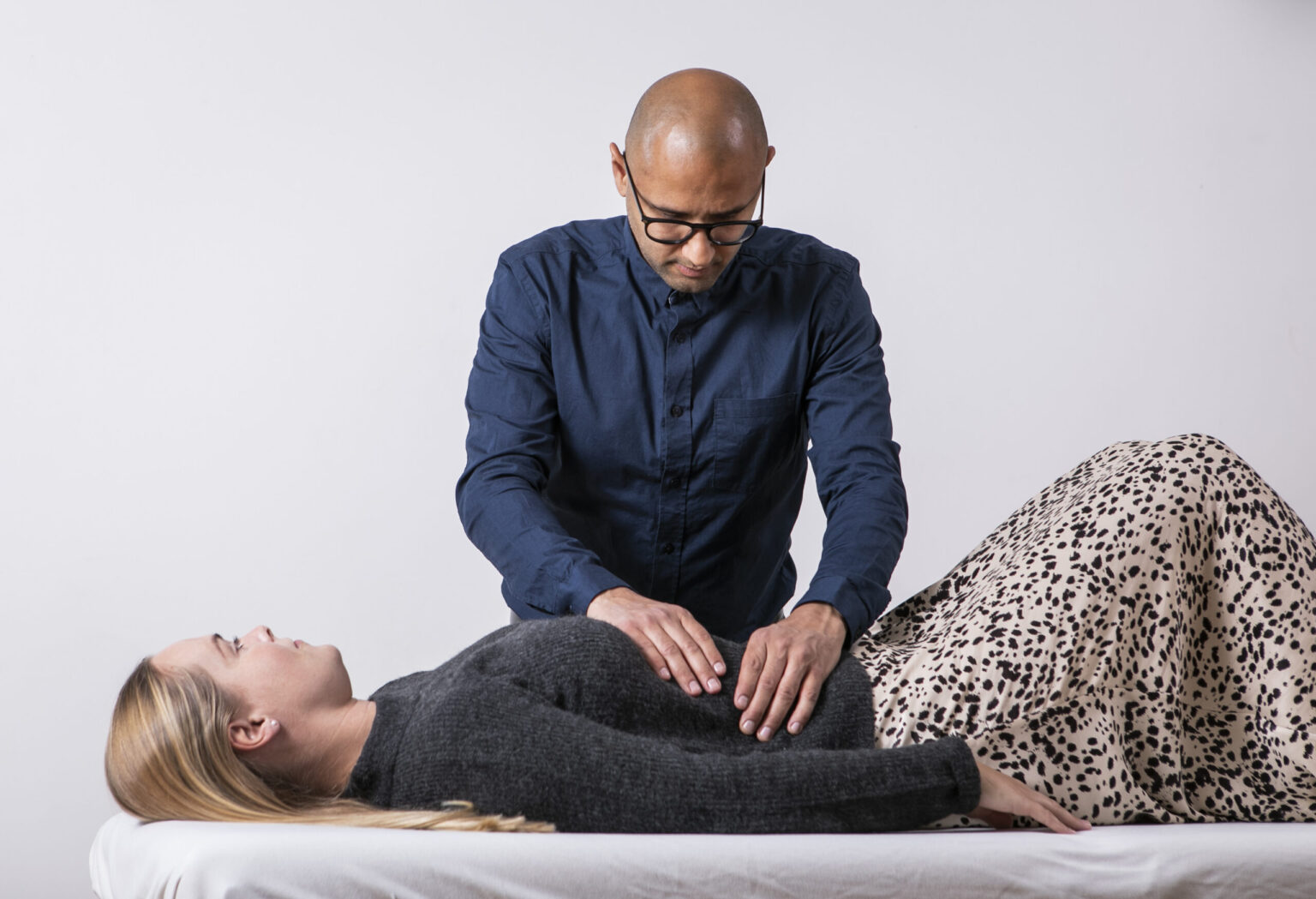We treat
Stomach pain due to stomach acid
Learn more about ulcers
Why do people get ulcers?
When food is ingested, it passes through the esophagus and into the stomach. The stomach produces enzymes and acid, which help digest the food. For further digestion, the food enters the duodenum (1).
Ulcer or peptic ulcer is a common term for an ulcer in the lining of the stomach, duodenum or the last part of the esophagus.
A common cause of this can be an infection with the bacterium Helicobacter pylori, which infects the lining of the stomach and increases acid production. Another common cause can be attributed to the intake of medications such as aspirin and NSAIDs, such as ibuprofen.
In general, the prevalence of Helicobacter pylori is decreasing in the Danish population due to increasing hygiene standards. Nevertheless, the bacterium is responsible for 40-60% of ulcers that develop in those affected.
In rare cases, cancer can play a role in the development of ulcers if the ulcer is located in the stomach (2).
Jump to section [Vis]
Stomach acid content
Stomach acid is essential for breaking down food, absorbing protein and nutrients, and acts as a barrier against bacteria, as the acidic environment in the stomach makes it difficult for harmful bacteria to thrive. Too little stomach acid (hypochlorhydria) can have many consequences, such as constipation, poor gut flora, and a risk of infection, which increases the risk of developing ulcers. Conversely, too much stomach acid can also have a number of consequences, such as acid reflux, heartburn, poor digestion, and ulcer formation due to the acidity of the stomach acid.

Lifestyle factors and ulcers
Helicobacter pylori (H. pylori) is, as previously mentioned, a common cause of ulcers, although its incidence is decreasing. However, not everyone develops ulcers because they have the bacteria in their stomach.
In addition to H. pylori, certain lifestyle factors may contribute to the development and worsening of ulcers, including high intake of NSAIDs (e.g. ibuprofen) and smoking.
For a long time, it was also believed that alcohol, spicy food and stress could cause ulcers, but this has proven not to be the case (3).
Symptoms of ulcers
Typical symptoms of a ulcer are described as a squeezing and/or burning sensation in the upper abdomen and chest. However, the symptoms can vary greatly from person to person and can be more diffuse and uncharacteristic.
Often the symptoms are relieved by eating, but this is only short-lived. After 1-2 hours the symptoms worsen again.
The short-term relief is due to the food having an acid-neutralizing effect in the stomach, but this neutralization is temporary, and after some time the food will have a stimulating effect on acid production, which explains the subsequent worsening of the symptoms.
Diagnosing ulcers
If you suspect a ulcer, your doctor may refer you to a gastroscopy, which is a visual examination of the stomach and upper part of the small intestine. The examination can detect ulcers and take tissue samples from the stomach lining.
If you suspect you have H. pylori infection and have mild symptoms, your doctor can test you for the bacteria using a stool or breath test. The stool test can reveal whether a protein from the bacteria is present. In a breath test, the patient ingests a liquid with a harmless tracer. If the bacteria are present, the tracer will be converted into radioactive carbon, which is exhaled and can be measured.

Strategies and lifestyle changes
Previously, it was believed that food and drink had a major influence on the course of peptic ulcers. However, there is no research that shows that one particular diet is better than another, either for preventing or treating peptic ulcers. Although acidic foods and alcohol can aggravate symptoms, they do not necessarily make the condition worse.
If you have a ulcer, it means that a disease process is underway and the body is working to combat chemical stress, especially if you are taking certain medications. Therefore, a healthy and varied diet is recommended to give the body the best conditions for recovery (5).
Treatment of ulcers
If the ulcer is caused by H. pylori, medication is recommended. A combination of antacids and antibiotics for 7-10 days will cure 90-95% of cases. The antibiotics kill the bacteria, while the antacids give the stomach time to heal.
If the ulcer is caused by arthritis medication such as an NSAID, it is recommended to stop taking this medication or switch to a medication with fewer side effects. In such cases, medication that reduces stomach acid may be appropriate. Treatment typically lasts 2-4 weeks.
However, there is a risk that the ulcer may come back later. Although treatment is often effective, new ulcers may develop in the stomach. Lifestyle changes, such as improved hygiene, can reduce the risk of becoming infected with H. pylori. Regular consultations with your doctor or other qualified health care professionals can also help reduce the risk of relapse (3).
When should you seek medical attention?
Untreated ulcers can be dangerous, so it is important to seek medical attention if you suspect you have a ulcer, as they rarely go away on their own. There are certain symptoms that should be taken seriously, as they may indicate that the ulcer is acute or extensive:
- Nausea
- Fever
- Vomiting fresh or clotted blood
- Blood in the stool
- Severe abdominal pain, possibly with pain radiating to the back
- Anemia
- Weight loss without obvious cause
If you notice any changes in your stool or vomiting, you should be extra careful. Black stools can be a sign that there is clotted blood in the intestines. Vomiting that looks like coffee grounds can also indicate the presence of clotted blood (1).

Osteopathy and stomach ulcers
Osteopathic treatment can complement traditional treatment for ulcers by focusing on improving the body’s overall function and supporting the healing process. Here are some ways in which osteopathic treatment can help relieve ulcers:
Improving Blood Circulation
Osteopaths work with techniques that can improve blood flow to the stomach area. Increased blood circulation can help speed up the healing of ulcers by ensuring that the stomach tissue receives adequate oxygen and nutrients.
Reducing Stress and Tension
Stress can worsen the symptoms of peptic ulcers. Osteopathic treatment can help reduce stress and muscle tension through techniques such as gentle massage and stretching exercises. This can help balance the autonomic nervous system and support the body’s ability to heal itself.
Improving Digestion
Osteopathy can address movement and function issues in the abdominal area by releasing tension and improving mechanical function. This can help improve digestion and reduce the discomfort associated with ulcers.
Correct Posture Adjustment
Osteopaths can help correct posture and movement patterns that can affect the digestive system. Correct posture can reduce pressure on the abdominal area and improve overall well-being.
Support for the Autonomic Nervous System
Osteopathic treatment can help balance the autonomic nervous system, which controls digestion. This can lead to a reduction in stomach acid production and improve the digestive process.
Holistic Treatment
Osteopaths look at the whole body and how different systems are interconnected. By taking a holistic approach, they can help identify and treat underlying issues that may contribute to ulcers, such as chronic stress or muscle tension.
Osteopathic treatment should always be seen as a supplement to, not a substitute for, conventional medical treatment. It is important to continue with the recommended medical treatment and advice from your doctor while considering osteopathic treatment as part of your overall care.
Exercises related to ulcers

Often related pain

Side stitch

Hidden constipation

Urinary incontinence

Celiac disease

Ulcer

Hernia

Lactose intolerance

